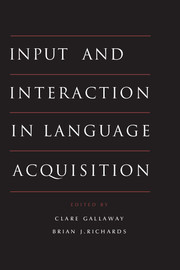Book contents
- Frontmatter
- Contents
- List of figures
- List of tables
- List of contributors
- Preface
- Introduction
- Part I General issues
- Part II Specific aspects of input and interaction
- 5 The rest of the family: the role of fathers and siblings in early language development
- 6 Phonetic and prosodic aspects of Baby Talk
- 7 Language learning at home and school
- Part III Types of language learner
- Conclusion
- References
- Author index
- Subject index
7 - Language learning at home and school
Published online by Cambridge University Press: 05 June 2012
- Frontmatter
- Contents
- List of figures
- List of tables
- List of contributors
- Preface
- Introduction
- Part I General issues
- Part II Specific aspects of input and interaction
- 5 The rest of the family: the role of fathers and siblings in early language development
- 6 Phonetic and prosodic aspects of Baby Talk
- 7 Language learning at home and school
- Part III Types of language learner
- Conclusion
- References
- Author index
- Subject index
Summary
The structure of classroom discourse
It has often been observed that going to school presents young children with a range of problems. Not least of these is the change in their relationship with adults from intimate individual contact with parents to relatively impersonal contact with a teacher who is responsible for the care, control, and education of a large group of children. This is a matter of great consequence since the quality of the interpersonal relations in the classroom inevitably influences the patterns of discourse which, in turn, have an impact upon the children's learning. Research over the last twenty-five years has exposed patterns of classroom talk which have been criticized as allowing few opportunities for children to be active participants in the educational process. Typically, classroom talk has been shown to be not only rigidly structured but also teacher-dominated.
One of the early studies of classroom talk was conducted by Sinclair and Coulthard (1975) at the University of Birmingham. However, this was not educational research. As linguists, their objective was to develop an initial model for the systematic study of discourse. They chose to analyze classroom talk as a starting point for their project because it seemed simpler than casual conversation: the classroom offered a highly structured situation in which meanings were likely to be relatively unambiguous and one participant was responsible for the allocation of turns and the direction taken by the discussion.
- Type
- Chapter
- Information
- Input and Interaction in Language Acquisition , pp. 153 - 180Publisher: Cambridge University PressPrint publication year: 1994
- 6
- Cited by



